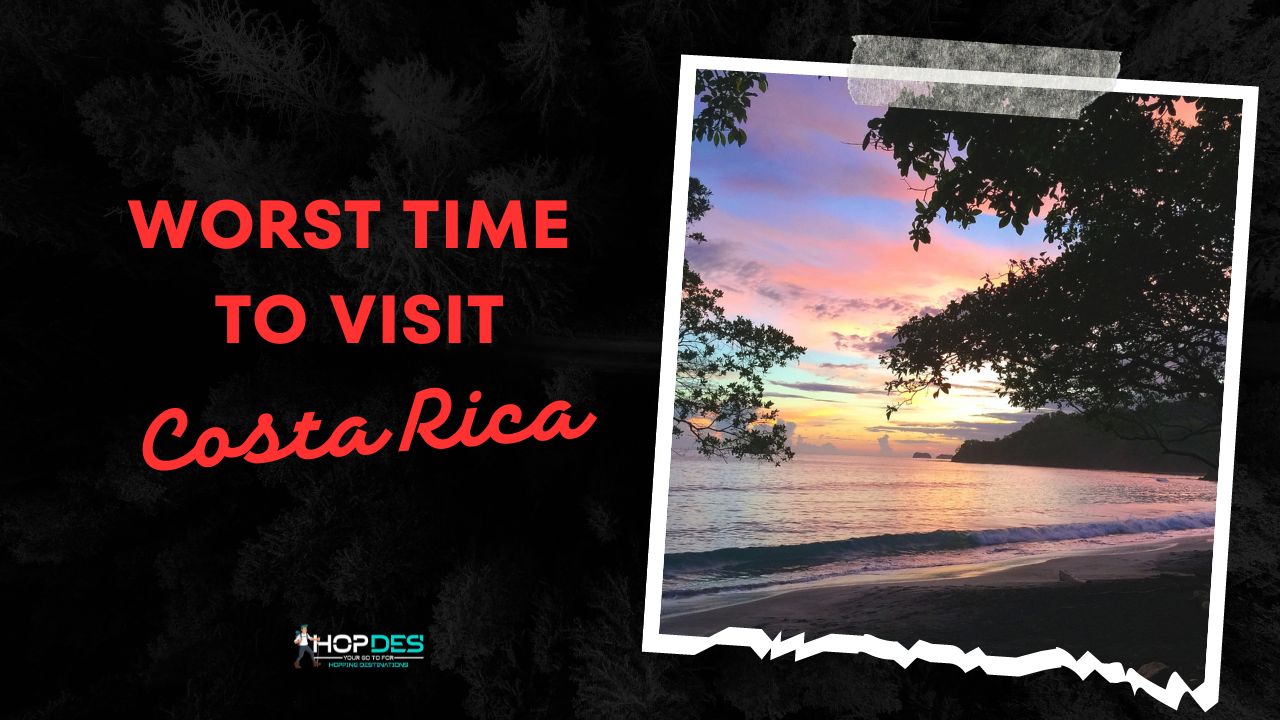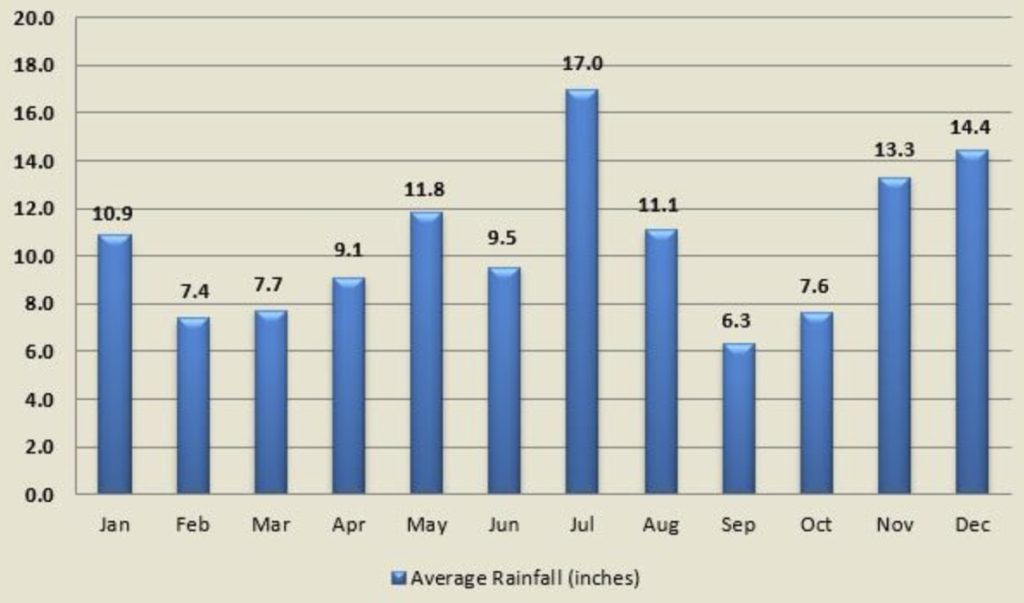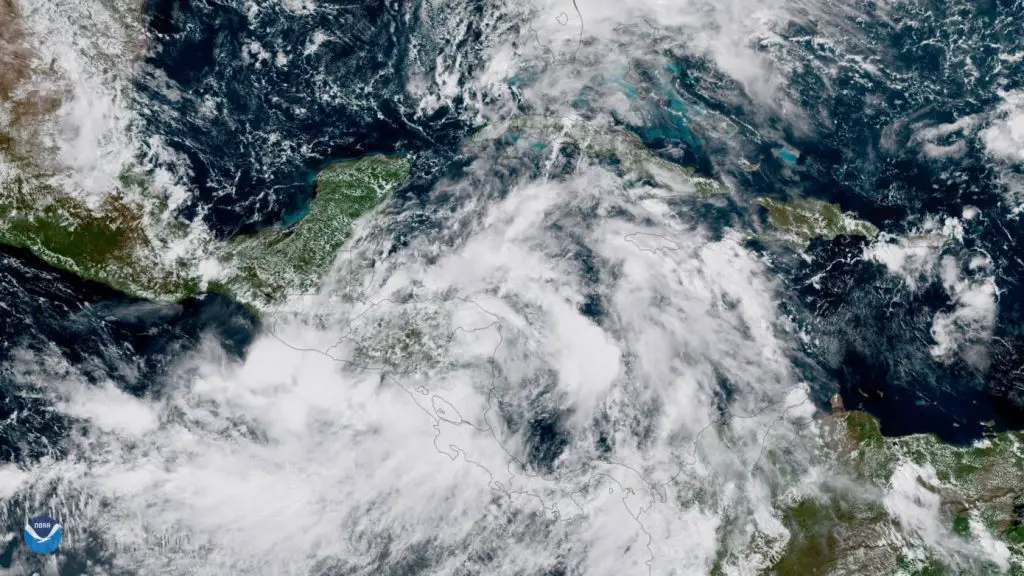
Previously, we talked about the worst time to visit Australia and Barbados. This time, we decided to give Costa Rica a go. Costa Rica, nestled between the Caribbean and Pacific coasts, captures the imagination of travelers worldwide. Renowned for rainforests, national parks, waterfalls, and natural marvels, understanding its seasons is vital for planning.
This comprehensive travel guide will shed light on the worst time to visit Costa Rica to help you make informed decisions and optimize your Costa Rican adventure.
Worst Time To Visit Costa Rica
The rainy season, which extends from May to November, is the not the right time to visit Costa Rica. Due to frequent rainfalls that lead to flooding and mudslides, travel plans become quite challenging and hazardous.

- During this period, certain attractions such as national parks and beaches may have limited operating hours or be completely closed due to inclement weather, limiting the available activities for visitors.
- Additionally, driving conditions can be perilous on unpaved roads as heavy rainfall causes road washouts and landslides, leading to road closures that can last for several days.
Some notorious locations prone to such closures include the Pan American Highway (Hwy 2) south of San Jose to San Isidro de el General, Caldera Highway (Hwy 27) from Escazu to Caldera on the Pacific, Guapiles Highway (Hwy 32) from San Jose to the Caribbean, and Arenal Lake Road (Route 142) from La Fortuna to Tilaran, which is the main route from the volcano to the Guanacaste beaches and Monteverde cloud forest.
Costa Rica’s Additional Challenges
In addition to the challenges mentioned earlier, there are a few more factors that contribute to the least favorable time to visit Costa Rica:
Hurricanes
The hurricane season poses significant obstacles and is considered the worst time to visit Costa Rica, spanning from early June to late November.

- Costa Rica has experienced several deadly and destructive hurricanes, including Hurricane Nate.
- On average, the country encounters one hurricane per year.
- One notable hurricane, “Bonnie” made landfall in Costa Rica from June 22 to July 9, 2022, reaching a wind speed of up to 74 km/h near Limón and having a diameter of 65 kilometers.
- Limón and Guanacaste are particularly vulnerable to these hurricanes, resulting in extensive damage and disruption to infrastructure, transportation, and local communities.
Considering the potential dangers and risks associated with hurricanes, it is advisable to avoid visiting Costa Rica during the rainy season, especially if you plan to explore Limón and Guanacaste.
Suggested Reading: Worst Time to Visit Scotland – Why to Avoid Winters?
Off Season
The months of April through November in Costa Rica are generally referred to as the “off-season,” coinciding with the country’s rainy season. During this season, certain attractions, national parks, shops, restaurants, and resorts may be closed or have limited operating hours.
Let’s say you have your heart set on witnessing the mesmerizing nesting sea turtles at Tortuguero National Park. You plan your visit in November, expecting to be captivated by this incredible natural phenomenon. However, it’s important to be aware that November may not be the best time to fulfill this dream.

The sea turtle season, which spans from July to October, concludes before November arrives. As a result, the chances of encountering nesting sea turtles during this month are significantly reduced.
Just be sure to plan accordingly, check for any closures or schedule changes, and come prepared for the occasional rain shower that adds its own charm to the Costa Rican experience.
ALERT: Scorpions In Seasonal Transition
Costa Rica is home to a diverse range of animals, including scorpions, which are commonly found throughout the country.
- Scorpions, especially Centruroides and Margaritatus have a tendency to seek shelter in homes and hotel rooms, particularly to find cool and dry environments.
- Occasionally, they may hide between stacked clothing or even inside shoes, which can be an unpleasant surprise for visitors.
- In terms of their activity patterns, scorpions tend to be more active during seasonal transitions.
For example, when Costa Rica shifts from the rainy season to the dry season, there is often an increase in scorpion sightings. Common areas where they may be found include under stoves, refrigerators, or closets but close to areas with a lot of trees mainly.
For some visitors, the presence of scorpions can create an unfavorable experience, especially for those with a fear or dislike of these arachnids. Further, visitors may feel hesitant to explore outdoor activities or spend time in natural environments including the dry areas of the Pacific, as well as metropolitan and rainforest areas.

Crime Rate In Peak Season
Visitors to Costa Rica should be aware of the high petty crime rate, during the peak tourist seasons from November to May and July to August.
- Instances of pickpocketing, purse snatching, and other forms of petty theft are frequent during these times.
- Passport theft is a significant concern as well.
Criminals typically operate in teams, with one member distracting the victims while the other steals their belongings. Tourist hotspots, such as popular viewpoints, buses, trains, stations, airports, hotel lobbies, and restaurants (especially those near streets), are common locations for theft.

Falling victim to theft during this time can turn a visit into a worst-case scenario, especially if cherished items like your precious diamond jewelry or passports are stolen.
Related: Worst Time to Visit Bali – Which Months to Avoid?
Mosquito Season
The mosquito season in Costa Rica runs from May to November. The presence of mosquitos in Costa Rica can significantly worsen your visit.
- These pests can be found during the rainy season, and they are known carriers of diseases such as dengue, chikungunya, and zika.
- Getting bitten by mosquitos can lead to serious illnesses, causing discomfort and health concerns during your stay.
- Additionally, the constant annoyance of buzzing and the itchiness from mosquito bites can make your time in Costa Rica highly unpleasant.
Despite efforts by some establishments to provide mosquito repellent, it is essential to be proactive in protecting yourself and taking necessary precautions to avoid mosquito bites.

What is The Most Expensive Time in Costa Rica?
December in Costa Rica is a bustling month filled with festivals and events such as the Festival de las Luces, Christmas Eve celebrations, El Tope Nacional horse parade, and the San José Carnival, providing visitors with an opportunity to immerse themselves in the country’s vibrant culture and festive atmosphere.

- During this period, prices tend to be significantly higher, with costs being as much as 30% above average.
- For an average traveler staying in mid-priced accommodations, a week-long vacation in Costa Rica usually ranges from $850 to $1,450.
- However, if you plan to visit in December, the estimated cost is between $1,105 and $1,885.
- For those seeking luxury accommodations, the average price per night is approximately $130.
Which Period of the Year is Busiest in Costa Rica?
The months of December through April, known as the “high season,” are Costa Rica’s busiest and most popular. This period aligns with the high season and is particularly busy around school holidays. Tourists flock to Costa Rica to enjoy the warm and pleasant weather.

However, while the dry season offers ideal conditions for outdoor activities, it can also be the busiest and potentially the worst time to visit. The high number of tourists leads to limited availability and inflated prices for accommodations and leisure activities.
In 2022, December stood out as the most popular month among tourists, with over 260 thousand arrivals. Additionally, tourism booms in February and March, coinciding with Easter and the start of Spring Break.
To avoid the crowds and potential inconveniences, consider visiting Costa Rica at the end of January or the beginning of February. This way, you can still enjoy the excellent weather while minimizing the impact of the high tourist influx.
Costa Rica Month-by-Month Analysis: Decide Your Travel!
Costa Rica offers diverse weather conditions throughout the year, and what may be considered non-desirable weather for some can be perfect for others, depending on personal preferences and activities. Here’s a comprehensive list of each month in Costa Rica with important weather information and activities you can do:

January
- Temperatures: Average temperatures range from 70°F (21°C) to 85°F (29°C).
- Activities: Enjoy the dry season, go hiking in national parks, explore rainforests, visit Arenal Volcano, go zip-lining, and enjoy water sports like surfing and snorkeling.
- Weather: Generally sunny and dry with occasional showers on the Caribbean coast.
- Expense: Considered peak tourist season, so prices for accommodation and activities can be relatively high.
February
- Temperatures: Similar to January, with average temperatures between 70°F (21°C) and 85°F (29°C).
- Activities: Continue to enjoy the dry season, explore cloud forests, visit wildlife reserves, go whale watching on the Pacific coast, and indulge in beach activities.
- Weather: Dry and sunny with occasional showers on the Caribbean coast.
- Expense: Similar to January, prices can be high due to peak season.
March
- Temperatures: Average temperatures range from 70°F (21°C) to 85°F (29°C).
- Activities: Explore national parks, go birdwatching, visit the Monteverde Cloud Forest, go scuba diving or snorkeling, and enjoy beach relaxation.
- Weather: The dry season continues with warm and sunny days.
- Expense: Prices can still be relatively high, especially in popular tourist areas.
April
- Temperatures: Average temperatures range from 70°F (21°C) to 85°F (29°C).
- Activities: Enjoy the end of the dry season, go hiking in rainforests, visit hot springs, explore the Osa Peninsula, and engage in adventure activities like white-water rafting.
- Weather: Transition from dry to rainy season with some showers and increasing humidity.
- Expense: Prices may start to decrease as the high tourist season ends.
May
- Temperatures: Average temperatures range from 70°F (21°C) to 85°F (29°C).
- Activities: Experience the start of the rainy season, visit Tortuguero National Park to see sea turtle nesting, go fishing, explore waterfalls, and enjoy river tours.
- Weather: Increasing rainfall and humidity, especially in the afternoons.
- Expense: Prices generally decrease compared to the peak season, making it a more affordable time to visit.
June
- Temperatures: Average temperatures range from 70°F (21°C) to 85°F (29°C).
- Activities: Enjoy the lush green landscapes, visit the Arenal Volcano, go hiking, explore the Nicoya Peninsula, and engage in water sports like kayaking and paddleboarding.
- Weather: Rainy season continues with frequent afternoon showers and occasional thunderstorms.
- Expense: Prices remain relatively low, making it an affordable time to visit.
July
- Temperatures: Average temperatures range from 70°F (21°C) to 85°F (29°C).
- Activities: Take advantage of the green season, visit the Manuel Antonio National Park, go surfing, explore the Rincon de la Vieja National Park, and enjoy wildlife watching.
- Weather: Rainy season continues with occasional heavy downpours, but mornings are usually sunny.
- Expense: Prices remain low, making it an affordable time to visit.
August
- Temperatures: Average temperatures range from 70°F (21°C) to 85°F (29°C).
- Activities: Explore the Osa Peninsula, visit the Corcovado National Park, go whale watching, enjoy jungle treks, and engage in snorkeling or diving.
- Weather: Rainy season continues, with occasional heavy showers and high humidity.
- Expense: Prices remain relatively low, making it an affordable time to visit.
September
- Temperatures: Average temperatures range from 70°F (21°C) to 85°F (29°C).
- Activities: Experience the green season, visit the Caribbean coast, explore the Tortuguero National Park, go river rafting, and enjoy cultural festivals.
- Weather: Rainy season continues with frequent showers and high humidity.
- Expense: Prices remain low, making it an affordable time to visit, but note that some places may close for maintenance or renovations.
October
- Temperatures: Average temperatures range from 70°F (21°C) to 85°F (29°C).
- Activities: Enjoy the green season, visit the Arenal Volcano, go horseback riding, explore the Monteverde Cloud Forest, and take advantage of quieter beaches.
- Weather: Rainy season continues with frequent showers and high humidity.
- Expense: Prices remain low, making it an affordable time to visit, but some attractions may have limited hours or be closed.
November
- Temperatures: Average temperatures range from 70°F (21°C) to 85°F (29°C).
- Activities: Explore national parks, visit the Guanacaste region, go zip-lining, enjoy cultural events, and indulge in beach activities.
- Weather: Transition from rainy to dry season with decreasing rainfall and more sunny days.
- Expense: Prices may start to increase as the high season approaches, but they are still relatively affordable compared to peak months.
December
- Temperatures: Average temperatures range from 70°F (21°C) to 85°F (29°C).
- Activities: Enjoy the start of the dry season, visit the Manuel Antonio National Park, go snorkeling or diving, explore coffee plantations, and celebrate Christmas and New Year’s in Costa Rica.
- Weather: Beginning of the dry season with sunny and warm days.
- Expense: Prices start to increase as the peak tourist season begins, especially during the holiday period.
Conclusion
The rainy season, spanning from May to November, is widely regarded as the least popular time to visit Costa Rica. During this period, frequent rainfalls can lead to flooding, which may limit access to popular attractions and outdoor activities. Further, Peak tourist seasons, higher crime rates, higher prices, and the rainy season with more mosquitoes make it the worst time to visit Costa Rica.
Worst Time to Visit Costa Rica - FAQs
Costa Rica is the most expensive to visit during December – January as there is a rush of tourists due to Christmas and other festivals.
The off-season, known as the green season, occurs from April to November, characterized by increased precipitation and fewer tourists.
The hurricane season in Costa Rica typically runs from June to November.
